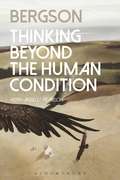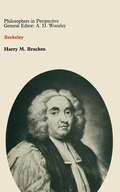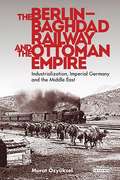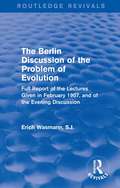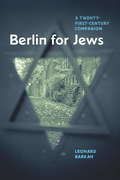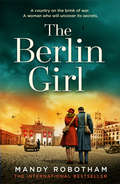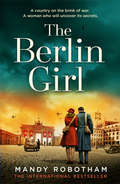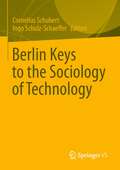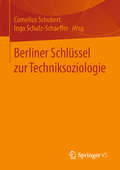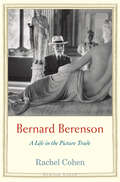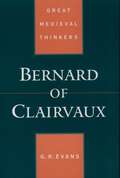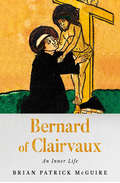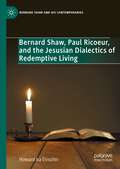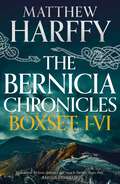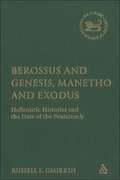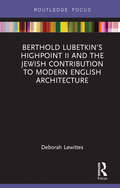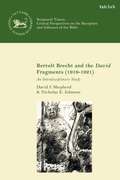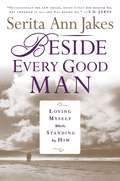- Table View
- List View
Bergson: Thinking Beyond the Human Condition
by Keith Ansell PearsonA thought-provoking contribution to the renaissance of interest in Bergson, this study brings him to a new generation of readers. Ansell-Pearson contends that there is a Bergsonian revolution, an upheaval in philosophy comparable in significance to those that we are more familiar with, from Kant to Nietzsche and Heidegger, that make up our intellectual modernity. The focus of the text is on Bergson's conception of philosophy as the discipline that seeks to 'think beyond the human condition'. Not that we are caught up in an existential predicament when the appeal is made to think beyond the human condition; rather that restricting philosophy to the human condition fails to appreciate the extent to which we are not simply creatures of habit and automatism, but also organisms involved in a creative evolution of becoming. Ansell-Pearson introduces the work of Bergson and core aspects of his innovative modes of thinking; examines his interest in Epicureanism; explores his interest in the self and in time and memory; presents Bergson on ethics and on religion, and illuminates Bergson on the art of life.
Bergson: Thinking Beyond the Human Condition (Athlone Contemporary European Thinkers Ser.)
by Keith Ansell PearsonA thought-provoking contribution to the renaissance of interest in Bergson, this study brings him to a new generation of readers. Ansell-Pearson contends that there is a Bergsonian revolution, an upheaval in philosophy comparable in significance to those that we are more familiar with, from Kant to Nietzsche and Heidegger, that make up our intellectual modernity. The focus of the text is on Bergson's conception of philosophy as the discipline that seeks to 'think beyond the human condition'. Not that we are caught up in an existential predicament when the appeal is made to think beyond the human condition; rather that restricting philosophy to the human condition fails to appreciate the extent to which we are not simply creatures of habit and automatism, but also organisms involved in a creative evolution of becoming. Ansell-Pearson introduces the work of Bergson and core aspects of his innovative modes of thinking; examines his interest in Epicureanism; explores his interest in the self and in time and memory; presents Bergson on ethics and on religion, and illuminates Bergson on the art of life.
The Berlin-Baghdad Railway and the Ottoman Empire: Industrialization, Imperial Germany and the Middle East (Library of Ottoman Studies)
by Murat ÖzyükselRailway expansion was the great industrial project of the late 19th century, and the Great Powers built railways at speed and reaped great commercial benefits. The greatest imperial dream of all was to connect the might of Europe to the potential riches of the Middle East and the Ottoman Empire. In 1903 Imperial Germany, under Kaiser Wilhelm II, began to construct a railway which would connect Berlin to the Ottoman city of Baghdad, and project German power all the way to the Persian Gulf. The Ottoman Emperor, Abdul Hamid II, meanwhile, saw the railway as a means to bolster crumbling Ottoman control of Arabia. Using new Ottoman Turkish sources, Murat Özyüksel shows how the Berlin-Baghdad railway became a symbol of both rising European power and declining Ottoman fortunes. It marks a new and important contribution to our understanding of the geopolitics of the Middle East before World War I, and will be essential reading for students of empire, Industrial History and Ottoman Studies.
The Berlin Discussion of the Problem of Evolution: Full Report of the Lectures Given in February 1907, and of the Evening Discussion
by Erich Wasmann, S.J.First published in 1909, this book collects the author’s lectures on the ‘problem of evolution’ and the resultant debate. The first considers the validity of the Theory of Evolution and whether it is in opposition to the Christian view of creation. The second examines the assertion that evolution harmonises only with Monism rather than Theism and which of the two views is preferable. It also looks at the popular identification of Darwinism with evolution, if it is scientific and the results this leads to. The third looks at man’s position in the problem of evolution — whether we are bound to bring in considerations higher than the zoological — and the evidence for our descent from ‘brutes’.
The Berlin Discussion of the Problem of Evolution: Full Report of the Lectures Given in February 1907, and of the Evening Discussion
by Erich Wasmann, S.J.First published in 1909, this book collects the author’s lectures on the ‘problem of evolution’ and the resultant debate. The first considers the validity of the Theory of Evolution and whether it is in opposition to the Christian view of creation. The second examines the assertion that evolution harmonises only with Monism rather than Theism and which of the two views is preferable. It also looks at the popular identification of Darwinism with evolution, if it is scientific and the results this leads to. The third looks at man’s position in the problem of evolution — whether we are bound to bring in considerations higher than the zoological — and the evidence for our descent from ‘brutes’.
Berlin for Jews: A Twenty-First-Century Companion
by Leonard BarkanWhat is it like to travel to Berlin today, particularly as a Jew, and bring with you the baggage of history? And what happens when an American Jew, raised by a secular family, falls in love with Berlin not in spite of his being a Jew but because of it? The answer is Berlin for Jews. Part history and part travel companion, Leonard Barkan’s personal love letter to the city shows how its long Jewish heritage, despite the atrocities of the Nazi era, has left an inspiring imprint on the vibrant metropolis of today. Barkan, voraciously curious and witty, offers a self-deprecating guide to the history of Jewish life in Berlin, revealing how, beginning in the early nineteenth century, Jews became prominent in the arts, the sciences, and the city’s public life. With him, we tour the ivy-covered confines of the Schönhauser Allee cemetery, where many distinguished Jewish Berliners have been buried, and we stroll through Bayerisches Viertel, an elegant neighborhood created by a Jewish developer and that came to be called Berlin’s “Jewish Switzerland.” We travel back to the early nineteenth century to the salon of Rahel Varnhagen, a Jewish society doyenne, who frequently hosted famous artists, writers, politicians, and the occasional royal. Barkan also introduces us to James Simon, a turn-of-the-century philanthropist and art collector, and we explore the life of Walter Benjamin, who wrote a memoir of his childhood in Berlin as a member of the assimilated Jewish upper-middle class. Throughout, Barkan muses about his own Jewishness, while celebrating the rich Jewish culture on view in today’s Berlin. A winning, idiosyncratic travel companion, Berlin for Jews offers a way to engage with German history, to acknowledge the unspeakable while extolling the indelible influence of Jewish culture.
Berlin for Jews: A Twenty-First-Century Companion
by Leonard BarkanWhat is it like to travel to Berlin today, particularly as a Jew, and bring with you the baggage of history? And what happens when an American Jew, raised by a secular family, falls in love with Berlin not in spite of his being a Jew but because of it? The answer is Berlin for Jews. Part history and part travel companion, Leonard Barkan’s personal love letter to the city shows how its long Jewish heritage, despite the atrocities of the Nazi era, has left an inspiring imprint on the vibrant metropolis of today. Barkan, voraciously curious and witty, offers a self-deprecating guide to the history of Jewish life in Berlin, revealing how, beginning in the early nineteenth century, Jews became prominent in the arts, the sciences, and the city’s public life. With him, we tour the ivy-covered confines of the Schönhauser Allee cemetery, where many distinguished Jewish Berliners have been buried, and we stroll through Bayerisches Viertel, an elegant neighborhood created by a Jewish developer and that came to be called Berlin’s “Jewish Switzerland.” We travel back to the early nineteenth century to the salon of Rahel Varnhagen, a Jewish society doyenne, who frequently hosted famous artists, writers, politicians, and the occasional royal. Barkan also introduces us to James Simon, a turn-of-the-century philanthropist and art collector, and we explore the life of Walter Benjamin, who wrote a memoir of his childhood in Berlin as a member of the assimilated Jewish upper-middle class. Throughout, Barkan muses about his own Jewishness, while celebrating the rich Jewish culture on view in today’s Berlin. A winning, idiosyncratic travel companion, Berlin for Jews offers a way to engage with German history, to acknowledge the unspeakable while extolling the indelible influence of Jewish culture.
Berlin for Jews: A Twenty-First-Century Companion
by Leonard BarkanWhat is it like to travel to Berlin today, particularly as a Jew, and bring with you the baggage of history? And what happens when an American Jew, raised by a secular family, falls in love with Berlin not in spite of his being a Jew but because of it? The answer is Berlin for Jews. Part history and part travel companion, Leonard Barkan’s personal love letter to the city shows how its long Jewish heritage, despite the atrocities of the Nazi era, has left an inspiring imprint on the vibrant metropolis of today. Barkan, voraciously curious and witty, offers a self-deprecating guide to the history of Jewish life in Berlin, revealing how, beginning in the early nineteenth century, Jews became prominent in the arts, the sciences, and the city’s public life. With him, we tour the ivy-covered confines of the Schönhauser Allee cemetery, where many distinguished Jewish Berliners have been buried, and we stroll through Bayerisches Viertel, an elegant neighborhood created by a Jewish developer and that came to be called Berlin’s “Jewish Switzerland.” We travel back to the early nineteenth century to the salon of Rahel Varnhagen, a Jewish society doyenne, who frequently hosted famous artists, writers, politicians, and the occasional royal. Barkan also introduces us to James Simon, a turn-of-the-century philanthropist and art collector, and we explore the life of Walter Benjamin, who wrote a memoir of his childhood in Berlin as a member of the assimilated Jewish upper-middle class. Throughout, Barkan muses about his own Jewishness, while celebrating the rich Jewish culture on view in today’s Berlin. A winning, idiosyncratic travel companion, Berlin for Jews offers a way to engage with German history, to acknowledge the unspeakable while extolling the indelible influence of Jewish culture.
Berlin for Jews: A Twenty-First-Century Companion
by Leonard BarkanWhat is it like to travel to Berlin today, particularly as a Jew, and bring with you the baggage of history? And what happens when an American Jew, raised by a secular family, falls in love with Berlin not in spite of his being a Jew but because of it? The answer is Berlin for Jews. Part history and part travel companion, Leonard Barkan’s personal love letter to the city shows how its long Jewish heritage, despite the atrocities of the Nazi era, has left an inspiring imprint on the vibrant metropolis of today. Barkan, voraciously curious and witty, offers a self-deprecating guide to the history of Jewish life in Berlin, revealing how, beginning in the early nineteenth century, Jews became prominent in the arts, the sciences, and the city’s public life. With him, we tour the ivy-covered confines of the Schönhauser Allee cemetery, where many distinguished Jewish Berliners have been buried, and we stroll through Bayerisches Viertel, an elegant neighborhood created by a Jewish developer and that came to be called Berlin’s “Jewish Switzerland.” We travel back to the early nineteenth century to the salon of Rahel Varnhagen, a Jewish society doyenne, who frequently hosted famous artists, writers, politicians, and the occasional royal. Barkan also introduces us to James Simon, a turn-of-the-century philanthropist and art collector, and we explore the life of Walter Benjamin, who wrote a memoir of his childhood in Berlin as a member of the assimilated Jewish upper-middle class. Throughout, Barkan muses about his own Jewishness, while celebrating the rich Jewish culture on view in today’s Berlin. A winning, idiosyncratic travel companion, Berlin for Jews offers a way to engage with German history, to acknowledge the unspeakable while extolling the indelible influence of Jewish culture.
The Berlin Girl
by Mandy RobothamThe heart-wrenching new WWII story from the bestselling author of The German Midwife.
The Berlin Girl
by Mandy RobothamFrom the bestselling author of The German Midwife comes the heart-wrenching story of a country on the brink of war, a woman who puts herself in the line of fire, and a world about to be forever changed.
Berlin Keys to the Sociology of Technology
by Cornelius Schubert Ingo Schulz-SchaefferThis volume offers a cross-section of a good fifteen years of research in the sociology of technology and innovation at the Department of Sociology of Technology headed by Werner Rammert at the TU Berlin. All contributions in this volume were initiated or discussed there and thus bear in a certain sense a "Berlin signature" - not in the sense of a clearly delimited scientific school, but rather in the form of an open discussion group with different, but mutually related focal points. The Berlin Key, which gives it its title, imposes on all its users the program of action objectified in its mechanism: "User, if you want to take the key back to yourself after unlocking the door and go your way, you must lock the door again first. Unlike that Berlin key, the "Berlin Keys to the Sociology of Technology" presented here offer a set of keys to different butinterconnected conceptual and methodological approaches in social science research on technology and innovation.
Berliner Schlüssel zur Techniksoziologie
by Cornelius Schubert Ingo Schulz-SchaefferDer Band bietet einen Querschnitt durch gut fünfzehn Jahre technik- und innovationssoziologischer Forschungen am von Werner Rammert geleiteten Fachgebiet für Techniksoziologie an der TU Berlin. Alle Beiträge dieses Bandes wurden dort angeregt oder diskutiert und tragen so in gewisser Weise eine „Berliner Handschrift“ – nicht im Sinne einer klar umgrenzten wissenschaftlichen Schule, sondern vielmehr in Gestalt eines offenen Diskussionszusammenhanges mit unterschiedlichen, aber wechselseitig aufeinander bezogenen Schwerpunktsetzungen. Der titelgebende Berliner Schlüssel zwingt allen seinen Benutzer*innen das in seinem Mechanismus objektivierte Handlungsprogramm auf: „Benutzer*in, wenn du, nachdem du die Tür aufgeschlossen hast, den Schlüssel wieder an dich nehmen und deiner Wege gehen willst, muss du die Tür zuvor wieder zuschließen.“ Anders als jener Berliner Schlüssel bieten die hier vorgelegten „Berliner Schlüssel zur Techniksoziologie“ einen Schlüsselbund unterschiedlicher, aber miteinander verbundener konzeptioneller und methodischer Herangehensweisen in der sozialwissenschaftlichen Technik- und Innovationsforschung.
Bernard Berenson: A Life in the Picture Trade (Jewish Lives)
by Rachel CohenWhen Gilded Age millionaires wanted to buy Italian Renaissance paintings, the expert whose opinion they sought was Bernard Berenson, with his vast erudition, incredible eye, and uncanny skill at attributing paintings. They visited Berenson at his beautiful Villa I Tatti, in the hills outside Florence, and walked with him through the immense private library-which he would eventually bequeath to Harvard-without ever suspecting that he had grown up in a poor Lithuanian Jewish immigrant family that had struggled to survive in Boston on the wages of the father’s work as a tin peddler. Berenson’s extraordinary self-transformation, financed by the explosion of the Gilded Age art market and his secret partnership with the great art dealer Joseph Duveen, came with painful costs: he hid his origins and felt that he had betrayed his gifts as an interpreter of paintings. Nevertheless his way of seeing, presented in his books, codified in his attributions, and institutionalized in the many important American collections he helped to build, goes on shaping the American understanding of art today. This finely drawn portrait of Berenson, the first biography devoted to him in a quarter century, draws on new archival materials that bring out the significance of his secret business dealings and the way his family and companions-including his patron Isabella Stewart Gardner, his lover Belle da Costa Greene, and his dear friend Edith Wharton-helped to form his ideas and his legacy. Rachel Cohen explores Berenson’s inner world and exceptional visual capacity while also illuminating the historical forces-new capital, the developing art market, persistent anti-Semitism, and the two world wars-that profoundly affected his life.
Bernard of Clairvaux (Great Medieval Thinkers)
by G. R. EvansIn this book the renowned medievalist G.R. Evans provides a concise introduction to St. Bernard of Clairvaux (1090-1153), a figure of towering importance on the twelfth-century monastic and theological scene. After a brief overview of Bernard's life, Evans focuses on a few major themes in his work, including his theology of spirituality and his theology of the political life of the Church. The only available introduction to Bernard's life and thought, this latest addition to the Great Medieval Thinkers series will appeal to a wide audience of students and scholars of history and theology.
Bernard of Clairvaux: An Inner Life
by Brian Patrick McGuireIn this intimate portrait of one of the Middle Ages' most consequential men, Brian Patrick McGuire delves into the life of Saint Bernard of Clairvaux to offer a refreshing interpretation that finds within this grand historical figure a deeply spiritual human being who longed for the reflective quietude of the monastery even as he helped shape the destiny of a church and a continent. Heresy and crusade, politics and papacies, theology and disputation shaped this astonishing man's life, and McGuire presents it all in a deeply informed and clear-eyed biography.Following Bernard from his birth in 1090 to his death in 1153 at the abbey he had founded four decades earlier, Bernard of Clairvaux reveals a life teeming with momentous events and spiritual contemplation, from Bernard's central roles in the first great medieval reformation of the Church and the Second Crusade, which he came to regret, to the crafting of his books, sermons, and letters. We see what brought Bernard to monastic life and how he founded Clairvaux Abbey, established a network of Cistercian monasteries across Europe, and helped his brethren monks and abbots in heresy trials, affairs of state, and the papal schism of the 1130s.By reevaluating Bernard's life and legacy through his own words and those of the people closest to him, McGuire reveals how this often-challenging saint saw himself and conveyed his convictions to others. Above all, this fascinating biography depicts Saint Bernard of Clairvaux as a man guided by Christian revelation and open to the achievements of the human spirit.
Bernard Shaw, Paul Ricoeur, and the Jesusian Dialectics of Redemptive Living (Bernard Shaw and His Contemporaries)
by Howard Ira EinsohnThis book explores a heretofore unremarked linkage between Bernard Shaw, the twentieth-century French thinker Paul Ricoeur, and Jesus of Nazareth. The ties that bind them are a foundational interest in the social teachings of the Nazarene and their use of a shared dialectics with respect to living the kind of compassionate life that holds out the promise in our contemporary world of achieving something approximating universal wellness on a healthy planet at peace with itself. This work argues that the three principal subjects of the study—independently of one another—used the same dialectical method to reach the same dialectically derived conclusion about how humans can live redemptively in a fractured world.
The Bernicia Chronicles Boxset: I-VI (The Bernicia Chronicles)
by Matthew Harffy'Historical fiction doesn't get much better than this.' Angus DonaldWe first encounter doughty warrior Beobrand in The Serpent Sword as he fights for King Edwin in Northumbria, while seeking vengeance for his brother's death. In The Cross and the Curse, Beobrand returns home a hero after a stunning victory against the Waelisc, but despite riches and fame for his skill in battle, he is soon surrounded by enemies and treachery on all sides. Blood and Blade sees Beobrand escorting a princess of Wessex to her new home in Northumbria, as bride of King Oswald. With Oswald away fighting the Picts, and old enemies closing in, it is up to Beobrand to overcome the plots and perils in their path and get his new queen safely home.In Killer of Kings, Beobrand finds himself caught up in bloody conflict as Penda of Mercia marches on the southern kingdoms just as Beobrand is sent on an important mission by his king. Warrior of Woden sees Beobrand, now a renowned warlord, fight for his king, Oswald of Northumbria, as Penda invades the kingdom in a clash of pagans and Christians and a battle for the soul of Albion. Storm of Steel sees Beobrand sail to lands he once knew on a perilous quest to avenge a girl kidnapped by slavers.Collected in a single volume for the first time, books 1–6 of the epic Bernicia Chronicles series featuring mighty Anglo-Saxon warlord Beobrand, including:THE SERPENT SWORD THE CROSS AND CURSE BLOOD AND BLADE KILLER OF KINGS WARRIOR OF WODEN STORM OF STEELReviewers on Matthew Harffy:'Nothing less than superb.' Historical Novel Society 'Beobrand is the warrior to follow.' David Gilman
Berossus and Genesis, Manetho and Exodus: Hellenistic Histories and the Date of the Pentateuch (The Library of Hebrew Bible/Old Testament Studies)
by Russell GmirkinBerossus and Genesis, Manetho and Exodus proposes a provocative new theory regarding the date and circumstances of the composition of the Pentateuch. Gmirkin argues that the Hebrew Pentateuch was composed in its entirety about 273-272 BCE by Jewish scholars at Alexandria that later traditions credited with the Septuagint translation of the Pentateuch into Greek. The primary evidence is literary dependence of Gen. 1-11 on Berossus' Babyloniaca (278 BCE) and of the Exodus story on Manetho's Aegyptiaca (c. 285-280 BCE), and the geo-political data contained in the Table of Nations. A number of indications point to a provenance of Alexandria, Egypt for at least some portions of the Pentateuch. That the Pentateuch, drawing on literary sources found at the Great Library of Alexandria, was composed at almost the same date as the Septuagint translation, provides compelling evidence for some level of communication and collaboration between the authors of the Pentateuch and the Septuagint scholars at Alexandria's Museum. The late date of the Pentateuch, as demonstrated by literary dependence on Berossus and Manetho, has two important consequences: the definitive overthrow of the chronological framework of the Documentary Hypothesis, and a late, 3rd century BCE date for major portions of the Hebrew Bible which show literary dependence on the Pentateuch.
Berthold Lubetkin’s Highpoint II and the Jewish Contribution to Modern English Architecture
by Deborah LewittesIn 1935, the Russian-born Jewish architect Berthold Lubetkin and his firm Tecton designed Highpoint, a block of flats in London, which Le Corbusier called ‘revolutionary’. Three years later, Lubetkin completed a companion design. Yet Highpoint II felt very different, and the sense that the ideals of modernism had been abandoned seemed hard to dispute. Had modern architecture failed to take root in England? This book challenges the belief that English architecture was on hiatus during the 1930s. Using Highpoint II as a springboard, Deborah Lewittes takes us on a journey through the defining moments of modern English architecture – the ‘high points’ of the period surrounding Highpoint II. Drawing on Lubetkin’s work and his writings, the book argues that he advanced influential, lasting theories which were rooted in his design for Highpoint II. Lubetkin’s work is explored within the context of wider Jewish emigration to London during the interwar years as well as the anti-Semitism that pervaded Britain during the 1930s. As Lewittes demonstrates, this decade was anything but quiet. Providing a new perspective on twentieth-century English architecture, this book is of interest to students and scholars in architectural history, urban studies, Jewish studies, and related fields.
Berthold Lubetkin’s Highpoint II and the Jewish Contribution to Modern English Architecture
by Deborah LewittesIn 1935, the Russian-born Jewish architect Berthold Lubetkin and his firm Tecton designed Highpoint, a block of flats in London, which Le Corbusier called ‘revolutionary’. Three years later, Lubetkin completed a companion design. Yet Highpoint II felt very different, and the sense that the ideals of modernism had been abandoned seemed hard to dispute. Had modern architecture failed to take root in England? This book challenges the belief that English architecture was on hiatus during the 1930s. Using Highpoint II as a springboard, Deborah Lewittes takes us on a journey through the defining moments of modern English architecture – the ‘high points’ of the period surrounding Highpoint II. Drawing on Lubetkin’s work and his writings, the book argues that he advanced influential, lasting theories which were rooted in his design for Highpoint II. Lubetkin’s work is explored within the context of wider Jewish emigration to London during the interwar years as well as the anti-Semitism that pervaded Britain during the 1930s. As Lewittes demonstrates, this decade was anything but quiet. Providing a new perspective on twentieth-century English architecture, this book is of interest to students and scholars in architectural history, urban studies, Jewish studies, and related fields.
Bertolt Brecht and the David Fragments: An Interdisciplinary Study (The Library of Hebrew Bible/Old Testament Studies)
by David J. Shepherd Nicholas E. JohnsonThis volume offers an examination of Brecht's largely forgotten theatrical fragments of a life of David, written just after the Great War but prior to Brecht winning the Kleist Prize in 1922 and the acclaim that would launch hisextraordinary career. David J. Shepherd and Nicholas E. Johnson take as their starting point Brecht's own diaries from the time, which offer a vivid picture of the young Brecht shuttling between Munich and the family home in Augsburg, surrounded by friends, torn between women, desperate for success, and all the while with 'David on the brain'.The analysis of Brecht's David, along with his notebooks and diaries, reveals significant connections between the reception of the Biblical David and one of Germany's most tumultuous cultural periods. Drawing on theatrical experiments conducted with an ensemble from Trinity College Dublin, this volume includes the first ever translation of the David fragments in English, an extensive discussion of the theatrical afterlife of David in the early twentieth century as well as new interdisciplinary insights into the early Brecht: a writer entranced by the biblical David and utterly committed to translating the biblical tradition into his own evolving theatrical idiom.
Bertolt Brecht and the David Fragments: An Interdisciplinary Study (The Library of Hebrew Bible/Old Testament Studies)
by David J. Shepherd Nicholas E. JohnsonThis volume offers an examination of Brecht's largely forgotten theatrical fragments of a life of David, written just after the Great War but prior to Brecht winning the Kleist Prize in 1922 and the acclaim that would launch hisextraordinary career. David J. Shepherd and Nicholas E. Johnson take as their starting point Brecht's own diaries from the time, which offer a vivid picture of the young Brecht shuttling between Munich and the family home in Augsburg, surrounded by friends, torn between women, desperate for success, and all the while with 'David on the brain'.The analysis of Brecht's David, along with his notebooks and diaries, reveals significant connections between the reception of the Biblical David and one of Germany's most tumultuous cultural periods. Drawing on theatrical experiments conducted with an ensemble from Trinity College Dublin, this volume includes the first ever translation of the David fragments in English, an extensive discussion of the theatrical afterlife of David in the early twentieth century as well as new interdisciplinary insights into the early Brecht: a writer entranced by the biblical David and utterly committed to translating the biblical tradition into his own evolving theatrical idiom.
Beside Every Good Man: Loving Myself While Standing By Him
by Serita Ann JakesThe wife of Bishop T.D. Jakes seeks to mentor and inspire all women-in all phases of life-on how to better enjoy life alongside their men. According to her, every woman has a man she is called to stand beside. Now, she shows each woman how to do so in a way that enhances both their lives.
